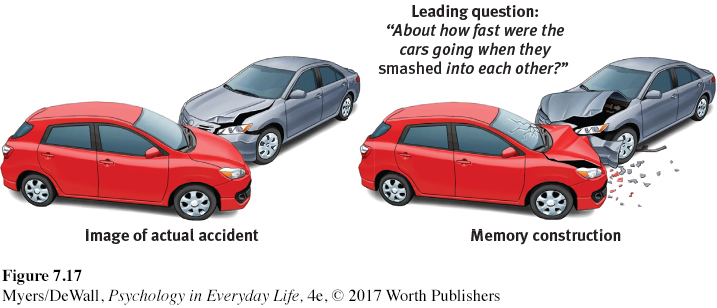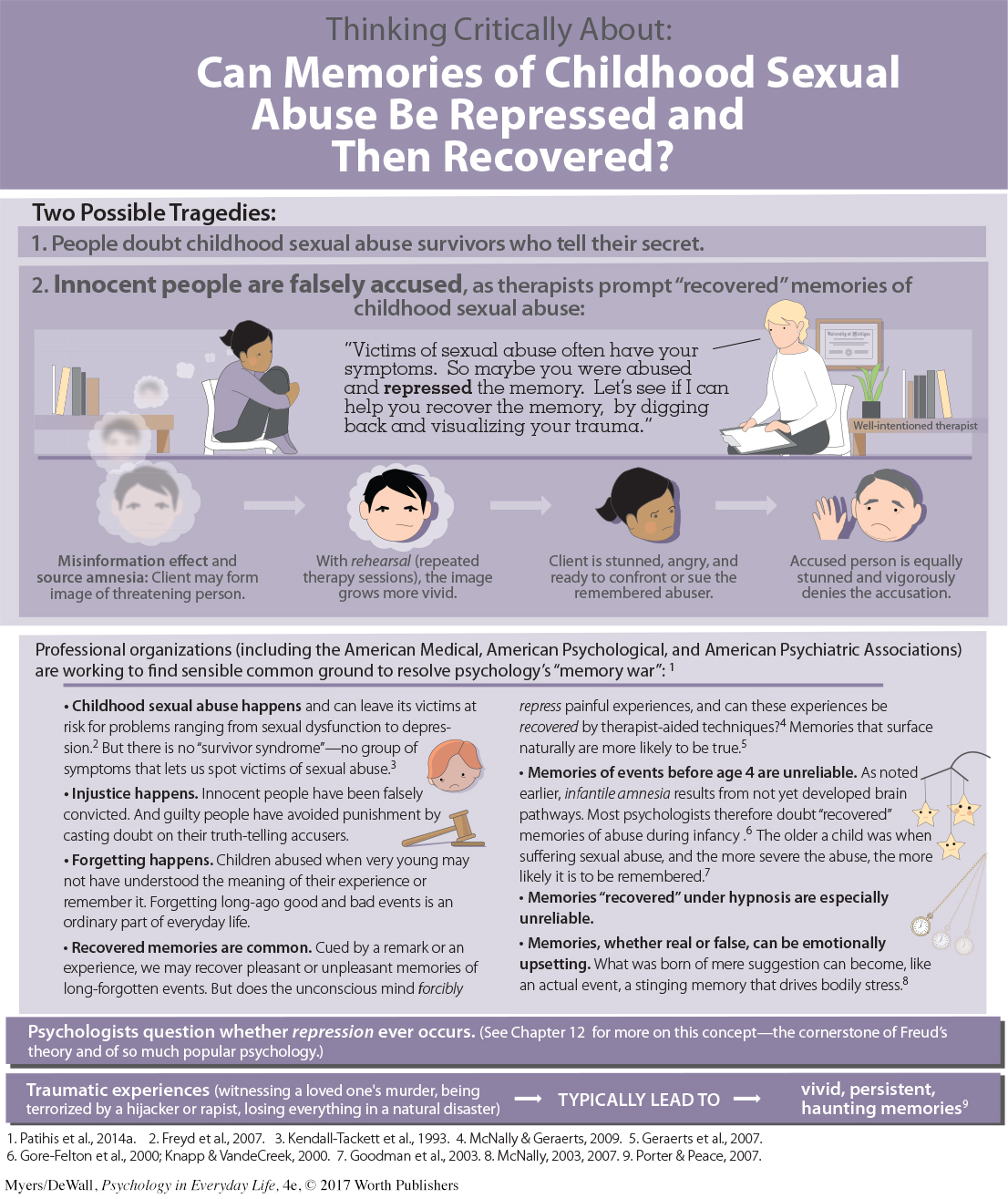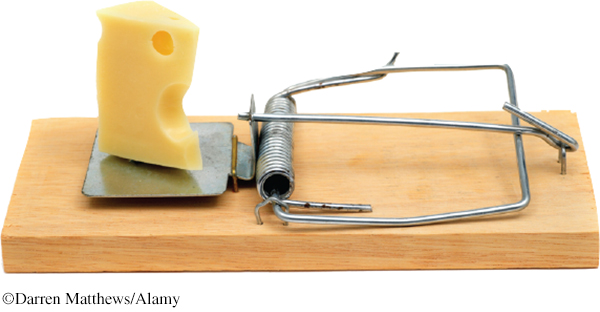7.6 Memory Construction Errors
LOQ 7-
reconsolidation a process in which previously stored memories, when retrieved, are potentially altered before being stored again.
Memory is not exact. Like scientists who infer a dinosaur’s appearance from its remains, we infer our past from stored tidbits of information plus what we later imagined, expected, saw, and heard. We don’t just retrieve memories; we reweave them (Gilbert, 2006). Our memories are like Wikipedia pages, capable of continuous revision. When we “replay” a memory, we often replace the original with a slightly modified version (Hardt et al., 2010). (Memory researchers call this reconsolidation.) So, in a sense, said Joseph LeDoux (2009), “your memory is only as good as your last memory. The fewer times you use it, the more [unchanged] it is.” This means that, to some degree, all memory is false (Bernstein & Loftus, 2009).

Despite knowing all this, I [DM] recently rewrote my own past. It happened at an international conference, where memory researcher Elizabeth Loftus (2012) was demonstrating how memory works. Loftus showed us a handful of individual faces that we were later to identify, as if in a police lineup. Then she showed us some pairs of faces, one face we had seen earlier and one we had not, and asked us to identify the one we had seen. But one pair she had slipped in included two new faces, one of which was rather like a face we had seen earlier. Most of us understandably but wrongly identified this face as one we had previously seen. To climax the demonstration, when she showed us the originally seen face and the previously chosen wrong face, most of us picked the wrong face! As a result of our memory reconsolidation, we—
212
Clinical researchers have experimented with memory reconsolidation. People recalled a traumatic or negative experience and then had the reconsolidation of that memory disrupted, with a drug or brief, painless electroconvulsive shock (Kroes et al., 2014; Lonergan, 2013). Someday it might become possible to erase your memory of a specific traumatic experience—
Misinformation and Imagination Effects
In more than 200 experiments involving more than 20,000 people, Loftus has shown how eyewitnesses reconstruct their memories when questioned after a crime or an accident. In one important study, two groups of people watched a film clip of a traffic accident and then answered questions about what they had seen (Loftus & Palmer, 1974). Those asked, “About how fast were the cars going when they smashed into each other?” gave higher speed estimates than those asked, “About how fast were the cars going when they hit each other?” A week later, when asked whether they recalled seeing any broken glass, people who had heard smashed in the leading (suggestive) version of the question were more than twice as likely to report seeing glass fragments (FIGURE 7.17). In fact, the film showed no broken glass.

“Memory is insubstantial. Things keep replacing it. Your batch of snapshots will both fix and ruin your memory. . . . You can’t remember anything from your trip except the wretched collection of snapshots.”
Annie Dillard, “To Fashion a Text,” 1988
misinformation effect when a memory has been corrupted by misleading information.
In many follow-
Just hearing a vivid retelling of an event may implant false memories. One experiment falsely suggested to some Dutch university students that, as children, they had become ill after eating spoiled egg salad (Geraerts et al., 2008). After absorbing that suggestion, they were less likely to eat egg salad sandwiches, both immediately and four months later.
Even repeatedly imagining fake actions and events can create false memories. Canadian university students were asked to recall two events from their past. One event actually happened; the other was a false event that involved committing a crime, such as assaulting someone with a weapon. Initially, none of the lawful students remembered breaking the law. But after repeated interviewing, 70 percent of students reported a detailed false memory of having committed the crime (Shaw & Porter, 2015).
Should we be surprised that digitally altered photos have produced the same result? In experiments, researchers have altered photos from a family album to show some family members taking a hot-
In British and Canadian university surveys, nearly one-
Source Amnesia
source amnesia faulty memory for how, when, or where information was learned or imagined.
What is the weakest part of a memory? Its source. Have you ever recognized someone but had no idea where you had met the person? Or dreamed about an event and later wondered whether it really happened? Or misrecalled how you learned about something (Henkel et al., 2000)? If so, you experienced source amnesia—you retained the memory of the event but not of its context. Source amnesia, along with the misinformation effect, is at the heart of many false memories. Authors and songwriters sometimes suffer from it. They think an idea came from their own creative imagination, when in fact they are unintentionally plagiarizing something they earlier read or heard.
213
Psychologist Donald Thompson became part of his own research on memory distortion when police brought him in for questioning about a rape. Although he was a near-
déjà vu that eerie sense that “I’ve experienced this before.” Cues from the current situation may unconsciously trigger retrieval of an earlier experience.
“Do you ever get that strange feeling of vujà dé? Not déjà vu; vujà dé. It’s the distinct sense that, somehow, something just happened that has never happened before. Nothing seems familiar. And then suddenly the feeling is gone. Vujà dé.”
Comedian George Carlin (1937–
Source amnesia also helps explain déjà vu (French for “already seen”). Two-
Retrieve + Remember
Question 7.18
•What—
ANSWER: Real experiences would be confused with those we dreamed. When seeing someone we know, we might therefore be unsure whether we were reacting to something they previously did or to something we dreamed they did.
Recognizing False Memories
We often are confident of our inaccurate memories. Because the misinformation effect and source amnesia happen outside our awareness, it is hard to separate false memories from real ones (Schooler et al., 1986). Perhaps you can recall describing a childhood experience to a friend and filling in memory gaps with reasonable guesses. We all do it. After more retellings, those guessed details—
 To participate in a simulated experiment on false memory formation, and to review related research, visit LaunchPad’s PsychSim 6: Can You Trust Your Memory? For a 5-
To participate in a simulated experiment on false memory formation, and to review related research, visit LaunchPad’s PsychSim 6: Can You Trust Your Memory? For a 5-
Memory construction errors can help us understand why some people have been sent to prison for crimes they never committed. Of 337 people who were later proven not guilty by DNA testing, 71 percent had been convicted because of faulty eyewitness identification (Innocence Project, 2015; Smalarz & Wells, 2015). “Hypnotically refreshed” memories of crimes often contain similar errors. If a hypnotist asks leading questions (“Did you hear loud noises?”), witnesses may weave that false information into their memory of the event. Memory construction errors also seem to be at work in many “recovered” memories of childhood abuse. See Thinking Critically About: Can Memories of Childhood Sexual Abuse Be Repressed and Then Recovered?
Children’s Eyewitness Recall
LOQ 7-
If memories can be sincere, yet sincerely wrong, how can jurors decide cases in which children’s memories of sexual abuse are the only evidence?
Stephen Ceci (1993) thinks “it would be truly awful to ever lose sight of the enormity of child abuse.” Yet Ceci and Maggie Bruck’s (1993, 1995) studies have made them aware of how easily children’s memories can be molded. For example, they asked 3-
214
LOQ 7-

215
In other experiments, the researchers studied the effect of suggestive interviewing techniques (Bruck & Ceci, 1999, 2004). In one study, children chose a card from a deck of possible happenings, and an adult then read the card to them. For example, “Think real hard, and tell me if this ever happened to you. Can you remember going to the hospital with a mousetrap on your finger?” In weekly interviews, the same adult repeatedly asked children to think about several real and fictitious events. After 10 weeks of this, a new adult asked the same questions. The stunning result: 58 percent of preschoolers produced false (often vivid) stories about one or more events they had never experienced (Ceci et al., 1994). Here’s one:
My brother Colin was trying to get Blowtorch [an action figure] from me, and I wouldn’t let him take it from me, so he pushed me into the wood pile where the mousetrap was. And then my finger got caught in it. And then we went to the hospital, and my mommy, daddy, and Colin drove me there, to the hospital in our van, because it was far away. And the doctor put a bandage on this finger.

 Consider how researchers have studied these issues with LaunchPad’s IMMERSIVE LEARNING: How Would You Know If People’s Memories Are Accurate?
Consider how researchers have studied these issues with LaunchPad’s IMMERSIVE LEARNING: How Would You Know If People’s Memories Are Accurate?
Given such detailed stories, professional psychologists who specialize in interviewing children could not reliably separate the real memories from the false ones. Nor could the children themselves. The child quoted above, reminded that his parents had told him several times that the mousetrap event never happened—
We shouldn’t forget that children can be accurate eyewitnesses. When a neutral person has asked nonleading questions soon after the event, using words the children could understand, children often accurately recalled what happened and who did it (Goodman & Quas, 2008; Pipe et al., 2004).
Retrieve + Remember
Question 7.19
•Imagine being a jury member in a trial for a parent accused of sexual abuse based on a recovered memory. What insights from memory research should you offer the jury?
ANSWER: It will be important to remember the key points agreed upon by most researchers and professional associations: Sexual abuse, injustice, forgetting, and memory construction all happen; recovered memories are common; memories from our first four years are unreliable; memories claimed to be recovered through hypnosis or drug influence are especially unreliable; and memories, whether real or false, can be emotionally upsetting.